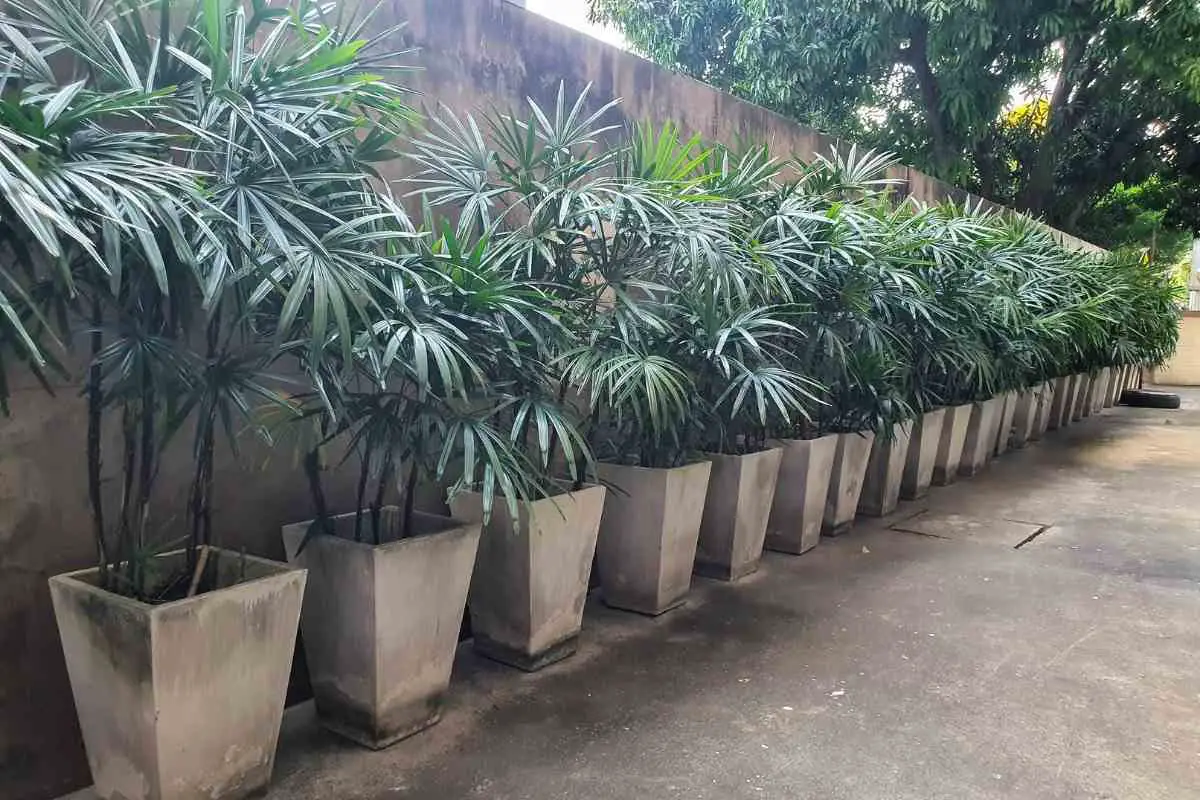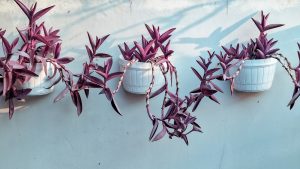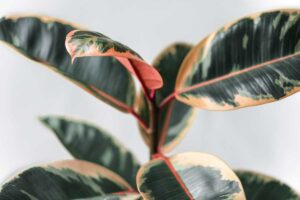The Lady Palm plant is part of the Arecaceae family of palm trees native to parts of China, Vietnam, and Thailand.
However, you will now find this evergreen outdoor and indoor beauty in homes, hotels, and offices worldwide.
House plants enthusiasts love this species for its proven tolerance to cool temperatures and low humidity requirements.
Lady Palms have broad leaves and bamboo-like stalks from which the leaves grow.
They form a rhizome root system that produces new plants when planted outdoors close together.
What to Expect? Ideal for both tropical and non-tropical regions in the US, they grow well and slowly indoors under minimal conditions.
Is Lady Palm Easy To Grow?
Due to its high tolerance to cold, low light, and humidity conditions, Lady Palm is one of the easiest indoor plants to grow.
However, it does not have a fast growth rate and may grow only a few inches tall each year.
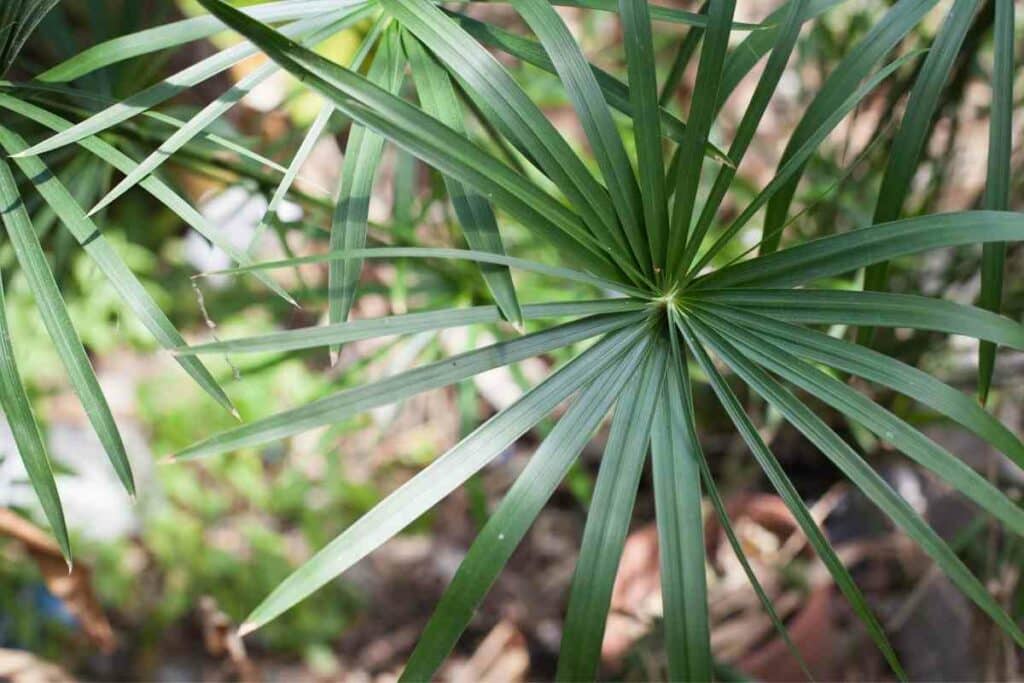
The perfect time to plant it outdoors or indoors is at the start of spring.
History Of The Lady Palm
Initially grown in southeast China, parts of Thailand, and Vietnam, the Lady Palms are not common in the wild.
They are grown indoors or in greenhouses.
Historians trace the first palm tree species to 16th century Japan and China.
It was common to find it in holy sites and temples as it added to the exotic green feel.
The beauty of the plants attracted people who then brought it to parts of North America, Europe, and the rest of the world.
Characteristics Of The Lady Palm
The Lady Palm grows with several stems right from the soil.
Each stem has thin bamboo-like fronds from which the green fan-shaped leaves sprout.

Indoors, the fronds grow to about 10 inches every year. As the frond grows, so does the number of leaves.
The leaves are slender and grow to about 20 inches long. Regular pruning prevents it from growing tall indoors.
Lady Palms flower. However, to do so, they require both a male and female plant to produce seeds. These need to be grown outdoors.
When left unpruned and outdoors, the plant also produces white flowers on the fronds.
The flowers, once fertilized, grow into white fruit, which is inedible and non-toxic.
How To Grow And Take Care Of Lady Palm
As a house plants beginner, there are a few things to consider when first planting Lady Palms.
They include the following.
1. Source of the plant
When first cultivating the Lady Palm, one can purchase the seeds or propagate young seedlings from a tree nursery.
Seeds
Growing Lady Palm from seeds requires soil rich in nutrients and warmth to germinate properly. Plant the seeds in shallow soil in a pot.
Water them regularly but avoid overwatering them. Keep the pot in a warm part of the house.
In about 25 days, you should see seedlings coming out.
Let them grow for 15 more days until they are tall enough to transplant to a bigger indoor pot or outside the garden.
Propagation
It is simple for beginners to propagate young seedlings by transplanting them from a tree nursery.
Transfer the young plants into a large pot, then fill it with enough loose moisture-rich soil.
Place a mat or a plastic tray underneath the pot to collect excess moisture.
As these plants become heavy with time, choose clay or heavy ceramic pots.
Works Best – Place it where there is enough light and warm air. You can move it to another location in a few months after it has grown tall.
2. Location of the Plants
Lady Palms can be grown indoors as houseplants or outdoors in the home garden area.
It is common to find the plants indoors, in the US, unlike in southeast China and Vietnam, where they grow outside.
They are hardy and give your interior a beautiful green look and feel without requiring direct and bright sunlight.
When well taken care of, they can thrive to maturity in a short time. Place them where they have sufficient light but not direct sunlight.
3. Conditions necessary for the plants to thrive

Grow and expose your Lady Palms to the right conditions if they are to flourish.
The most critical requirements for your plants are the following.
Soil
Lady Palms do well in soil with high nutrients and can adequately retain moisture.
Preferably silt or loam soil with PH levels of between 6 to 8.
Ensure the earth is loose around the plant when you first put it into the pot.
Loosening the topsoil allows water to get absorbed more accessibly into the rest of the soil.
Humidity and Temperature
Lady Palms thrive in medium to low humidity areas.
Young seeds and seedlings require warm temperatures of around 40 F to grow.
Once they are older, they can withstand the cold and freezing winter temperatures.
Regular misting of the leaves provides them with moisture.
Light
Although they prefer indirect but bright light, Lady Palms can tolerate shallow light.
You can place them in areas with partial shade. Consider exposing them to light a few hours a day, especially when young.
Water
Lady Palms require moderate watering. It is a drought-resistant plant that requires even less watering during winter.
Let the soil dry out before watering in the winter. Ensure the rest of the earth has moisture but is not wet.
Over-watering the plant will cause the roots to rot.
Plant food
Fertilizers and plant food can be added to the soil during planting to provide nutrients.
Additionally: Add them to the plants during the hot seasons but do not overdo it. Mix with water for proper absorption.
4. Maintenance of the Plants

Lady Palms require regular maintenance to grow to maturity like any other plant.
Pruning
Although they do not require regular pruning, you can cut off any leaves that change color either from:
- age
- excess light
- disease
- or lack of nutrients
Avoid this by ensuring they grow in the best conditions.
Do not cut the young green tubes of new shoots as you can damage them prematurely.
Make sure to remove any diseased stems immediately from the roots as they can poison and kill the entire plant.
Pests and Disease Control
House plants attract pests and insects despite being highly resistant.
Keep the bugs, aphids, mosquitoes, and spiders away by spraying mild pesticides or insecticides once you notice them.
Bugs love the moisture in the soil and green leaves.
Wipe the leaves down regularly with water and little soap to clean off any excess pesticides.
Potting
Lady Palms do not require regular repotting as long as the original container is large enough.
The roots grow deep and wide, and moving the plants would damage the roots.
Pick larger pots when you first plant them to give the roots room to grow to maturity.
Varieties Of Lady Palm Plants
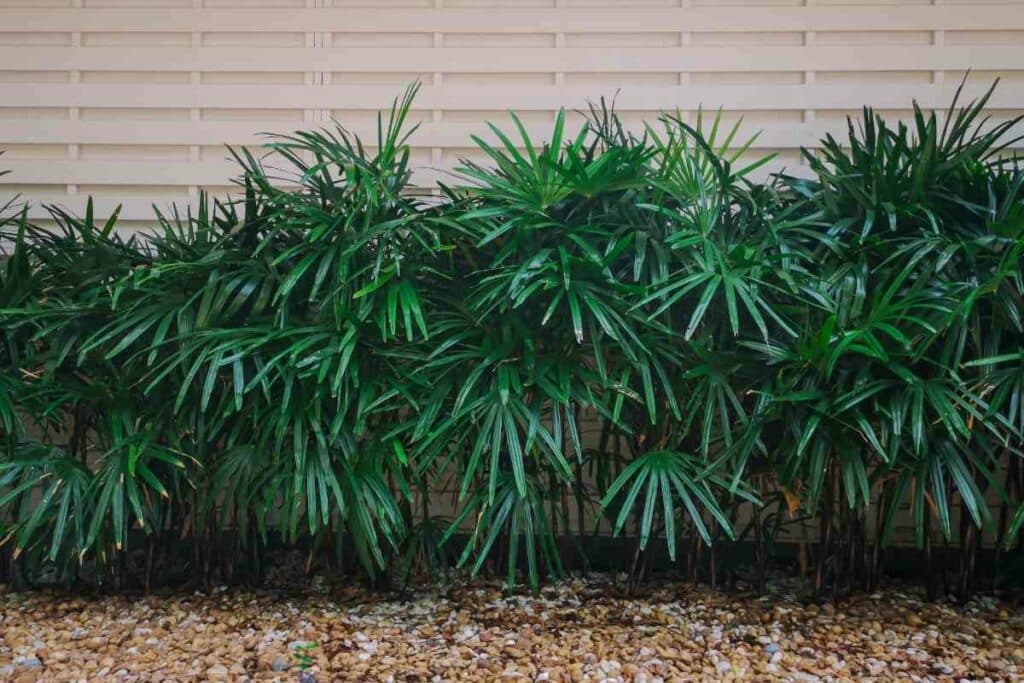
There are four different varieties of Lady Palm plants.
1. Thai Lady Palm
Also known as Rhapis Subtilis, small leaves with curved blades characterize this plant. It is short and gets bushy.
It grows up to a maximum of about five feet tall with a preference for high humidity.
2. Slender Lady Palm
Known as Reed Rhapis or Rhapis Humilis, it has green leaves with a fan-like shape.
They grow slowly indoors and can get as high as 12 feet tall.
They do well in shaded areas and in large pots to allow the growth of the roots.
3. Laos Lady Palm
Native to Vietnam and also known as Rhapis Laosensis or Conchinchinensis.
The leaves are thin and long, with the stems growing up to 3 feet long.
Its glossy green appearance does well in tropical locations. However, you’ll rarely find it in colder areas.
4. Bamboo or Broadleaf Lady Palm
The most common indoor plant variety is known as the Rhapis Excelsa.
It is evergreen with long fan-shaped leaves.
Easy to grow up to 15 feet long and under low light and humidity.
It has received numerous agricultural awards for its resistance to harsh conditions.
Frequently Asked Questions About The Lady Palm
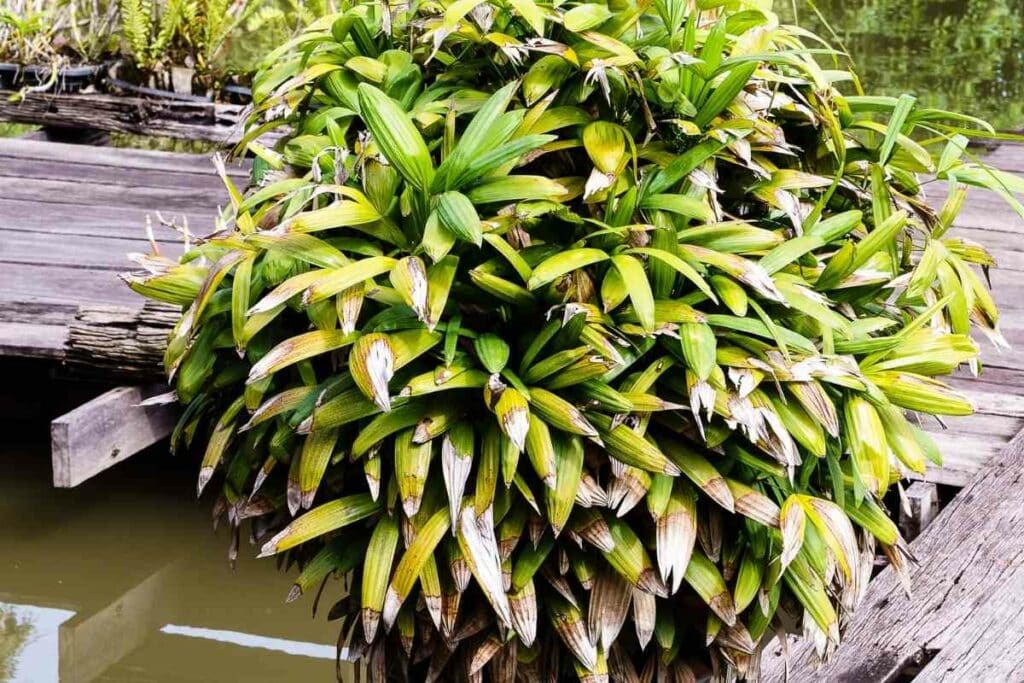
How long do Lady Palms take to grow?
It takes up to 5 years for Lady Palms to reach maturity. Some varieties can take about seven years.
How long should I water my Lady Palm?
Lady palm plants require moderate watering due to their drought-resistant capabilities.
During the hot seasons, ensure the soil has enough moisture.
In the Cold Season – Only water them if the earth at the top looks dry.
In case the tips of the leaves turn brown, it is an indication of a lack of sufficient water.
How much sunlight does a Lady Palm need?
Expose your Lady Palm plants to medium and low light for the best growth.
Less than 2 hours a day of direct sunlight will not harm the plants, but some shade is preferable.
Its leaves turn a lovely deep green when grown under a shade.
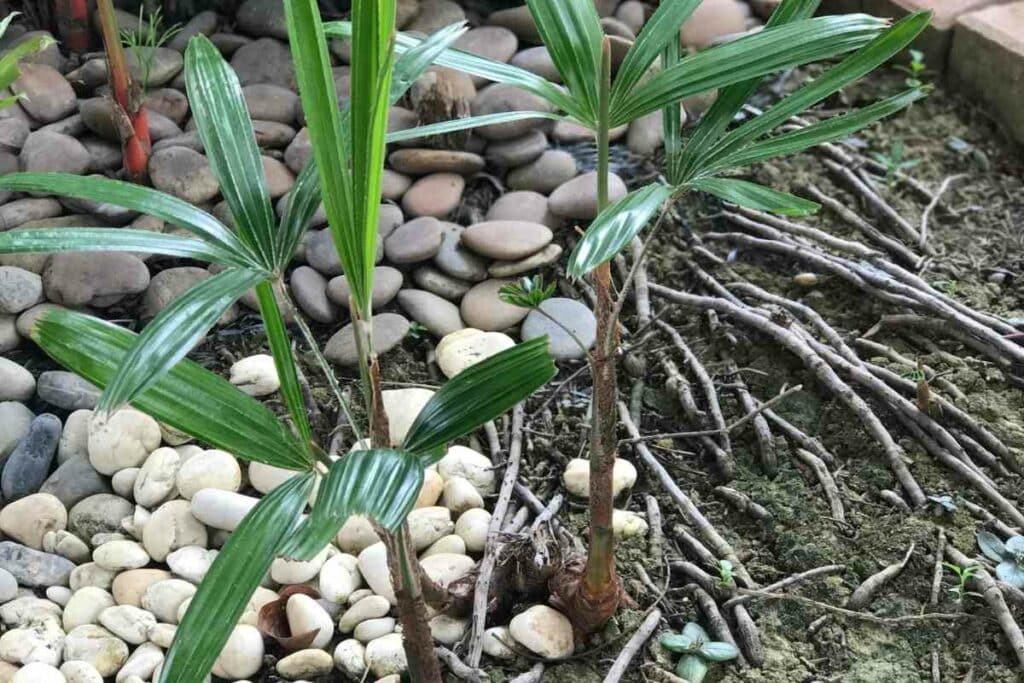
Is Lady Palm Invasive?
Mildly. Although you can sometimes see the roots near the excess water drainage holes in the pot, they do not extend out much.
Lady Palm roots grow slowly, and hence, it may be a few years before you can notice any extended rooting.
Plant them in big-sized pots to give the roots enough room.
Can I grow Lady Palms outdoors?
You can grow your Lady Palms outside if the spot does not allow direct sunlight.
One can place them around the exterior wall of the house, enclosed porch, roofed balcony, or a shaded backyard.
When grown closely together, they form thick clusters which can be used as protective screens.
Landscapers also use them as shrubs to cover the front of homes and outdoor living spaces.
How do you care for broadleaf Lady Palms?
Mainly grown indoors, broadleaf Lady Palms are excellent air purifiers that require low maintenance.
As long as there is enough light, moisture in the soil, and a little plant food, they will grow well.
Water them once a week, keeping a keen eye on the texture and wetness of the soil.
How high do Lady Palms grow?
A mature Lady Palm plant can be as tall as 15 feet if grown outdoors. Indoor Lady Palms grow to about 7 feet tall.
Every year, they can produce at least a foot long.
The Bamboo palm variety is best to grow on the property line or edge as a natural screen.
It reaches above 10 feet tall if the area is well shaded.
Can you trim a Lady Palm?
You can trim the older leaves of your Lady Palm if they turn brown.
Trimming ensures the healthy new leaves get all the good nutrients and water.
If the whole plant turns brown, it is dead and hence cutting it down is the best solution.
Why do Lady Palms turn yellow?
If they lack proper nutrition, Lady Palms turn yellow.
To avoid this:
- Spray fertilizers regularly as they grow slowly.
- Test the pH level of the soil. If they are low, replace the earth with one that has the required nutrients.
- Check that the plant receives sufficient water.
- Increases the humidity by misting the leaves frequently.
Are Lady Palm’s cold hardy?

Lady Palm’s trunk is hairy and fiber-like. It retains moisture well under low light and can withstand cold temperatures of about 20 degrees F.
It thrives in USDA hardy Zones 8B to 11 with temperatures between 15 to 40 degrees F.
Is the Lady Palm poisonous?
The Lady Palm plant is not poisonous to children, adults, or pets.
It is considered a non-toxic air cleaner, excellent for your home and loved ones.
Why Do My Palms Trees Keep Dying?
Palm trees will keep dying if you overwater them, apply excess fertilizers, and expose them to direct sunlight for long hours.
They die if the soil doesn’t have the required nutrients or if there is an infestation of bugs and plant disease.
Take proper care of plants and employ the help of a professional gardener to assist if you are overwhelmed.
Conclusion
How you take care of your Lady Palms determines how long they last.
You will only get an exotic-looking plant oasis if you take the time to protect your plants from dying.
You do not require much to add these elegant plants to your home.
You Might Also Like
- Philodendron Care, Varieties, And Aesthetic Home Arrangements
- Best House Plants for Low Light – Thriving Indoors with Minimal Sunlight
- 15 Air-Purifying Houseplants That Release The Most Oxygen
- Purple Houseplants: Your Guide to Dramatic Indoor Beauty
- Philodendron Moonlight Vs. Golden Goddess
- How to Revive Your Rubber Plant: 6 Tips to Help Your Rubber Tree Thrive Again
